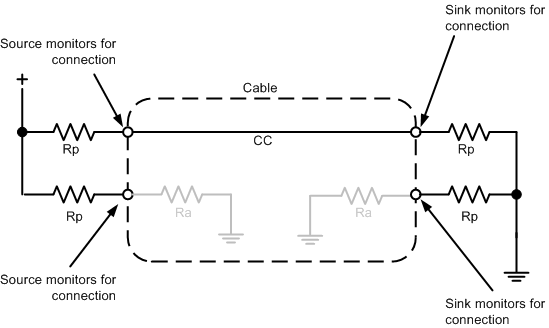SLVSE24C November 2017 – August 2019 TPS25820 , TPS25821
PRODUCTION DATA.
- 1 Features
- 2 Applications
- 3 Description
- 4 Revision History
- 5 Pin Configuration and Functions
- 6 Specifications
- 7 Detailed Description
-
8 Application and Implementation
- 8.1 Application Information
- 8.2 Typical Applications
- 9 Power Supply Recommendations
- 10Layout
- 11Device and Documentation Support
- 12Mechanical, Packaging, and Orderable Information
Package Options
Mechanical Data (Package|Pins)
- DSS|12
Thermal pad, mechanical data (Package|Pins)
- DSS|12
Orderable Information
7.1.3 Detecting a Connection
Sources and DRPs fulfill the role of detecting a valid connection over USB Type-C. Figure 9 shows a Source to Sink connection made with Type-C cable. As shown in Figure 9, the detection concept is based on being able to detect terminations in the product which has been attached. A pull-up and pull-down termination model is used. A pull-up termination can be replaced by a current source.
- In the Source-Sink connection the Source monitors both CC pins for a voltage lower than the unterminated voltage.
- A Sink advertises Rd on both its CC pins (CC1 and CC2).
- A powered cable advertises Ra on its VCONN pin.
 Figure 9. Source-Sink Connection Mechanism
Figure 9. Source-Sink Connection Mechanism